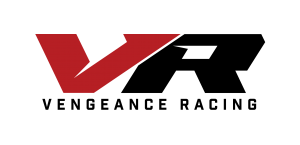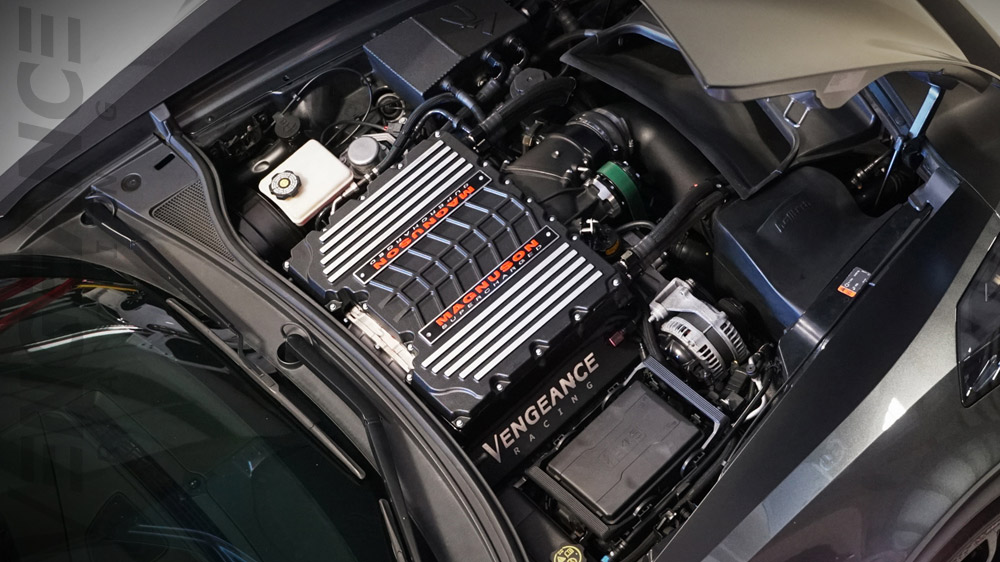Not everyone has complete knowledge how to properly make fast cars faster and we don’t expect you to… That’s our job! This page contains an overview of the components often installed at Vengeance Racing.
DYNO TUNING
Dyno tuning is the only way to correctly tune a car for Performance. Mail order tunes are good, but since evey car is different, and every car has different mods a dyno tune is needed. Dyno tunes allow the tuner to see what the car is doing from the start, and he/she can adjust the ECM for a peak HP output. Based on what that one car is doing. Mail order tunes can only guess how you car is running based on the test model they had when they wrote the program.
How it works:
You car will be put on a dyno, and hooked to a laptop via the ODB port under the steering wheel. They will make a few passes with the stock car to get a base line reading. From there the tuner can adjust the air/fuel ratio, advance the timing, remove rev limiters etc. They will adjust many things while making dyno runs in between changes to find the very best combo for your motor.
COLD AIR INTAKE
However your engine gets the air, cooler air is always better than the hot air right next to engine. Depending on your vehicle model a wide array of combinations are available to add 10-20 horsepower.
THROTTLE BODY
Don’t let your throttle body be a bottleneck in your air flow. We recommend a Nick Williams 102mm to mate up to the larger cold air and intake manifolds.
INTAKE MANIFOLD
The more air you can deliver to the engine the more power it’s going to make. There are various intake manifolds on the market claiming better flow and larger air inlets adding 20-35 horsepower.
HEADERS & EXHAUST
Headers are one of the easiest bolt-on accessories you can install to improve your engine’s performance. The goal of headers is to make it easier for your engine to push exhaust gases out of the cylinders. It works by eliminating the manifold’s back pressure. Instead of sharing a common manifold, each cylinder gets its own exhaust pipe. The individual pipes are cut and bent so that each one is the same length as the others, which guarantees that each cylinder’s exhaust gases arrive in the collector spaced out equally so there is no back pressure generated by the cylinders sharing the collector. Therefore, you notice more power and torque from your engine.
PULLEYS
Pulleys are a great way to free up horsepower to improve your vehicle’s performance. They reduce the power used to turn accessories so that extra power can be used at the transmission. Pulleys can also be used to turn up or down the flow of Superchargers.
CLUTCH
Stock clutch discs are excellent for daily driving and the occasional stomp on the gas pedal, but they will not withstand for very long the horsepower and torque that a racing engine will deliver. Because of this, the friction material on a racing clutch disc is much more rugged and sticky than a stock application. It bites harder and does not glaze, or become shiny, nearly as easily. A racing unit is also more thoroughly balanced to withstand higher RPM from the engine.
The pressure plate is what literally shoves the clutch disc into the flywheel. A racing pressure plate is capable of very high forces against the flywheel, which is measured in pounds. For instance, if the stock pressure plate in an automobile is rated at 2,500 lbs. of pressure against the flywheel, the racing application for the same vehicle will be rated at 5,000 lbs. This equates to stronger grabs at the start and a more solid feel all around. The pressure plates for racing are also precision balanced for high RPM engines.
FUEL SYSTEM
There are three main components of making power, which are air, spark, and most importantly.. FUEL. Fueling is a vital, and often under stated factor in any performance build. With today’s enthusiast seeking higher and higher power levels, larger and more advanced fuel systems are required to feed the engine. OEM fuel systems are designed to maintain the power that the car is provided with from the factory, so aftermarket solutions are required to provide additional support from the pumps and injectors. Also, alternative fuels are becoming much more popular such as E85, and these fuels both demand a lot more from the fuel system, as well as require specific components to prevent corrosion over time.
15″ CONVERSION
With the extreme power levels produced with aftermarket modifications on today’s vehicles, traction is an ever present issue. The ultimate solution for maximum traction on the drag strip or runway event is to go to the smallest wheel possible so that you can run the most sidewall available on a tire, as well as shed some weight in the car at the same time. Doing this however is not the most straight forward task as today’s vehicles have very large rear brakes that interfere with the smaller wheel fitments. Vengeance Racing offers a solution for most every vehicle to convert the brakes and suspension components where applicable to not only clear these smaller wheels, but in most cases also improve the suspension parts to help eliminate wheel hop and ultimately put the power down in your modified vehicle. We also offer several options from multiple wheel manufacturers to cater to most anyone’s style preference so that the car is not only functional but also looks as best as it can while going down the track.
HEADS & CAMSHAFTS
Internal combustion engines are, simply said, air pumps. The more air you pump into an engine, the more air/fuel you can burn, and the more power you can make. Building horsepower is not quite as simple as that, but it’s the basic concept. The cylinder head is the main component that flows air/fuel in and exhaust gases out. Needless to say, the cylinder head is a major component in building horsepower and torque.
The key parts of any camshaft are the lobes. As the camshaft spins, the lobes open and close the intake and exhaust valves in time with the motion of the piston. It turns out that there is a direct relationship between the shape of the cam lobes and the way the engine performs in different speed ranges.
NITROUS OXIDE
Nitrous Oxide Systems and kits are a great way to add power to your vehicle. Nitrous injected into the cylinders allows more fuel and oxygen to be burned, producing more power. There are various stages or shots used to bump up the horsepower. These systems can be button activated or computer controlled to ramp up the power gradually producing ideal results.
SUSPENSION
Today’s late model performance vehicles have some of the most advanced suspension systems available. These systems typically cater towards providing excellent handling characteristics while also providing the smoothest ride possible. However, for the performance enthusiast this may be a limiting factor to achieve the best possible lap times on the road course or ET in the ¼ mile. Vengeance Racing offers several performance suspension upgrades that will help any racer to eliminate performance robbing issues such as wheel hop, body roll, or lack of adjustability in the vehicle’s alignment. From lowering springs to sway bars, and all the way up to full coilover conversions, there are suspension upgrades available to meet most anyone’s demands from their high performance vehicle.
AIR to WATER INTERCOOLER SYSTEM
Custom air to water intercooler systems are available for most any supercharged or turbocharged application from Vengeance Racing. Air to water systems offer the ultimate solution for intake air temperature cooling by utilizing cold water to cool down the intake charge coming into the engine. These systems utilize a reservoir to fill with water and/or ice, intercooler cores, a heat exchanger, and custom charge piping to keep inlet temps cool in even the most extreme situations.
POSITIVE DISPLACEMENT
SUPERCHARGER
The Positive Displacement Supercharger or AKA “Roots blower” or is the simplest of all blowers and therefore is also the least expensive. A Roots blower does not compress the air inside the supercharger. It is actually an air pump. The compression of the inlet charge (creation of boost) actually takes place in the cylinders and the manifold. Centrifugal superchargers and screw type superchargers are called “internal compression” blowers because the air compression takes place inside the supercharger.
CENTRIFUGAL SUPERCHARGER
The centrifugal supercharger is very similar to a turbocharger, except the centrifugal supercharger is driven by a belt off the engine, while the turbocharger is driven by the force of the exhaust gases. These type of superchargers (or turbos) run at extremely high speeds. To achieve these high speeds in the centrifugal supercharger, there is an additional internal step-up drive inside the blower. Due to the design of these units, the faster the impeller spins the more boost the blower makes. As a result, these units typically do not produce much power at low engine speeds because the impeller is not spinning fast enough to make much boost. If it were even possible to gear the blower so that it would spin fast at low engine speeds, it would then make too much boost at higher engine speeds.
TURBOCHARGER
Turbochargers were originally known as turbosuperchargers when all forced induction devices were classified as superchargers. Nowadays the term “supercharger” is usually applied only to mechanically driven forced induction devices. The key difference between a turbocharger and a conventional supercharger is that a supercharger is mechanically driven by the engine, often through a belt connected to the crankshaft, whereas a turbocharger is powered by a turbine driven by the engine’s exhaust gas. Compared to a mechanically driven supercharger, turbochargers tend to be more efficient, but less responsive. Turbos employ a device called a “wastegate,” which bypasses exhaust gas past the turbo when a certain boost limit is reached.
COMPUTER MANAGEMENT
If you have invested a lot of money into an engine (which most of us do), it is a very good idea to protect that investment with an actual working fault management system controlling and monitoring everything from OEM fueling strategies, flex fuel control, traction control, individual cylinder knock control, boost control , launch control, 4 stage nitrous control, perfect idle stability, perfect start up, fault management, fuel pressure compensation, complete automatic transmission control etc
ENGINE INTERNALS
When preparing for your next high performance build, there are certain limiting factors from OEM components that will need to be addressed and upgraded to handle the power level that you’re looking to achieve. The internals of the engine itself are no different and often times not able to withstand extreme power levels and abuse in factory form. Items such as the crankshaft, connecting rods, pistons, and even the bearings and hardware need to be upgraded to handle high boost/power levels, extreme RPM, and overall racing situations to prevent failures. For example, the LT1 engine in the new C7 Corvette and 6th gen Camaro SS have a notoriously weak piston/piston ring design that often fails at the 650-700rwhp levels achieved when supercharging or turbocharging. For this, Vengeance Racing offers a fully forged piston with a much better ring setup that is a “drop-in” assembly so that you can utilize the OEM connecting rod as well as eliminate the need for a machine shop to rebalance the engine. There are many aftermarket solutions for upgraded engine internals no matter what the application, and it is something that certainly needs to be taken seriously to avoid both catastrophic and costly failures down the road.

